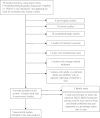NQO1 polymorphisms and de novo childhood leukemia: a HuGE review and meta-analysis
- PMID: 18945694
- PMCID: PMC2727266
- DOI: 10.1093/aje/kwn246
NQO1 polymorphisms and de novo childhood leukemia: a HuGE review and meta-analysis
Erratum in
- Am J Epidemiol. 2009 May 15;169(10):1280
Abstract
Polymorphisms in NQO1, a gene coding for the phase II enzyme involved in the detoxification of quinone carcinogens, have been associated with childhood leukemia in some studies, although the observed direction and magnitude of effects have been inconsistent. Therefore, the authors systematically reviewed all published reports describing the effect of NQO1 in de novo childhood leukemia and conducted a meta-analysis of 7 case-control studies that examined the association between NQO1*2 and childhood leukemia. Although a family-based study previously demonstrated over-transmission of this allele among childhood acute lymphoblastic leukemia cases, the meta-analysis showed that the presence of a NQO1*2 variant allele, which reduces the activity of the enzyme NAD(P)H:quinone oxidoreductase 1 (NQO1), had no significant effect on childhood leukemia. However, there was an increased risk associated with having at least 1 copy of the NQO1*2 allele in a subset of cases with MLL translocations (summary odds ratio = 1.39, 95% confidence interval: 0.98, 1.97). Heterogeneity between studies may be due to differences in population exposures to NQO1 substrates and small sample sizes, as well as potential population stratification in non-family-based studies. Therefore, further research is warranted on the role of NQO1 polymorphisms in the etiology of childhood leukemia, especially among MLL-positive leukemias.
Figures





Comment in
-
Re: "NQO1 polymorphisms and de novo childhood leukemia: a HuGE review and meta-analysis".Am J Epidemiol. 2009 May 15;169(10):1278-9; author reply 1279. doi: 10.1093/aje/kwp051. Epub 2009 Mar 30. Am J Epidemiol. 2009. PMID: 19332427 No abstract available.
Similar articles
-
Low NAD(P)H:quinone oxidoreductase activity is associated with increased risk of leukemia with MLL translocations in infants and children.Blood. 2002 Dec 15;100(13):4590-3. doi: 10.1182/blood-2001-12-0264. Epub 2002 Aug 1. Blood. 2002. PMID: 12393620
-
Genetic polymorphism of NAD(P)H:quinone oxidoreductase is associated with an increased risk of infant acute lymphoblastic leukemia without MLL gene rearrangements.Leukemia. 2005 Feb;19(2):214-6. doi: 10.1038/sj.leu.2403613. Leukemia. 2005. PMID: 15618957
-
NQO1 rs1800566 (C609T), PON1 rs662 (Q192R), and PON1 rs854560 (L55M) polymorphisms segregate the risk of childhood acute leukemias according to age range distribution.Cancer Causes Control. 2012 Nov;23(11):1811-9. doi: 10.1007/s10552-012-0060-5. Epub 2012 Sep 14. Cancer Causes Control. 2012. PMID: 22976839
-
Molecular biomarkers for the study of childhood leukemia.Toxicol Appl Pharmacol. 2005 Aug 7;206(2):237-45. doi: 10.1016/j.taap.2004.11.026. Toxicol Appl Pharmacol. 2005. PMID: 15967214 Review.
-
Association between NQO1 C609T polymorphism and acute lymphoblastic leukemia risk: evidence from an updated meta-analysis based on 17 case-control studies.J Cancer Res Clin Oncol. 2014 Jun;140(6):873-81. doi: 10.1007/s00432-014-1595-5. Epub 2014 Feb 2. J Cancer Res Clin Oncol. 2014. PMID: 24488035 Review.
Cited by
-
Current evidence for an inherited genetic basis of childhood acute lymphoblastic leukemia.Int J Hematol. 2013 Jan;97(1):3-19. doi: 10.1007/s12185-012-1220-9. Epub 2012 Dec 13. Int J Hematol. 2013. PMID: 23239135 Review.
-
The association between NQO1 Pro187Ser polymorphism and bladder cancer susceptibility: a meta-analysis of 15 studies.PLoS One. 2015 Jan 20;10(1):e0116500. doi: 10.1371/journal.pone.0116500. eCollection 2015. PLoS One. 2015. PMID: 25602258 Free PMC article.
-
Comparative distribution of Lysyl Oxidase (G473A) and NQO1 (C609T) polymorphism among tea-garden workers (habitual chewers of betel quid) of Darjeeling district and Kolkata city of West Bengal.Contemp Clin Dent. 2013 Oct;4(4):476-81. doi: 10.4103/0976-237X.123047. Contemp Clin Dent. 2013. PMID: 24403792 Free PMC article.
-
Association between NQO1 Pro187Ser polymorphism and esophageal cancer: a meta-analysis.Tumour Biol. 2014 Mar;35(3):2063-8. doi: 10.1007/s13277-013-1273-2. Epub 2013 Nov 10. Tumour Biol. 2014. PMID: 24213850
-
Polymorphisms in xenobiotic metabolizing genes (EPHX1, NQO1 and PON1) in lymphoma susceptibility: a case control study.BMC Cancer. 2013 May 7;13:228. doi: 10.1186/1471-2407-13-228. BMC Cancer. 2013. PMID: 23651475 Free PMC article.
References
-
- Jaiswal AK, McBride OW, Adesnik M, et al. Human dioxin-inducible cytosolic NAD(P)H:menadione oxidoreductase. cDNA sequence and localization of gene to chromosome 16. J Biol Chem. 1988;263(27):13572–13578. - PubMed
-
- Klassen C. Toxicology: The Basic Science of Poisons. New York, NY: McGraw-Hill; 2001.
-
- Nebert DW, Roe AL, Vandale SE, et al. NAD(P)H:quinone oxidoreductase (NQO1) polymorphism, exposure to benzene, and predisposition to disease: a HuGE Review. Genet Med. 2002;4(2):62–70. - PubMed
-
- Metodiewa D, Jaiswal AK, Cenas N, et al. Quercetin may act as a cytotoxic prooxidant after its metabolic activation to semiquinone and quinoidal product. Free Radic Biol Med. 1999;26(1–2):107–116. - PubMed
Publication types
MeSH terms
Substances
Grants and funding
LinkOut - more resources
Full Text Sources
Medical
Miscellaneous

